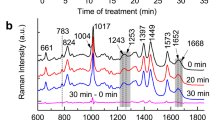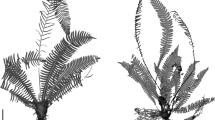Abstract
The ultrastructure of vegetative cells and spores of Bacillus pulvifaciens was studied by CTEM and SEM methods. The vegetative cells are rods, 1.6–4.5 μm long and 0.4–0.6 μm wide, exhibiting typical ultrastructural features of Gram-positive bacteria. The spores are of ellipsoidal shape, 0.6×1.2 μm in size, with six longitudinal ribs reaching up to 130 nm in height. There are satelite ribs on both sides of the longitudinal ribs, reaching up to 20 nm in height. Between the longitudinal ribs, additional transversal ribs were observed in SEM. A special tubular layer, separating the outer and inner coat of the spores, was revealed in ultrathin sections. This layer seems to be a typical ultrastructural feature of Bacillus pulvifaciens spores.
Similar content being viewed by others
References
Bakhiet N, Stahly DP (1985) Ultrastructure of sporulating Bacillus larvae in a broth medium. Appl Environ Microbiol 50: 690–692
Bulla StJ, rhodes RA, Hesseltine CW (1969) Scanning electron and phasecontrast microscopy of bacterial spores. Appl Microbiol 18: 490–495
Bradley DE, Franklin JG (1958) Electron microscope survey of the surface configuration of spores of the genus Bacillus. J Bacteriol 6: 618–630
Claus D, Berkeley RCW (1986) Genus Bacillus, In: Sneath PHA, Mair NS, Sharpe MR, Holt JG (eds) Bergey's manual of systematic bacteriology, vol 2, Williams and Wilkins, Baltimore, pp 1105–1139
Dingman DW, Stahly DP (1983) Medium promoting sporulation of Bacillus larvae and metabolism of medium components. Appl Environ Microbiol 46: 860–869
Gordon RE, Haynes WC, Pang CH (1973) The genus Bacillus. Agricultural Handbook No. 427. US Department of Agriculture, Washington DC
Haynes WC (1972) The catalase test: an aid in the identification of Bacillus larvae. Am Bee J 112: 130–131
Hitchcock JD, Stoner A, Wilson WT, Menapace DM (1979) Pathogeneity of Bacillus pulvifaciens to honey bee larvae of various ages (Hymenoptera: Apidae) J Kansas Entomol Soc 52: 238–246
Katznelson H (1950) Bacillus pulvifaciens (n.sp.) an organism associated with powdery scale of honney bee larvae. J Bacteriol 59: 153–159
Macnab RM, DeRosier DJ (1988) Bacterial flagellar structures and function. Can J Bacteriol 34: 442–451
Nakamura LK (1984) Bacillus pulvifaciens sp. nov., nom. rev. Int J Syst Bacteriol 34: 410–413
Reynolds ES (1963) The use of lead citrate at high pH as an electron-opaque stain in electron microscopy. J Cell Biol 17: 208–212
Séchaud J, Kelenberger E (1972) Electron microscopy of DNA-containing plasms. IV. glutaraldehyde-uranyl acetete fixation of virus-infected bacteria for thin sectioning. J Ultrastruct Res 39: 598–607
Skerman VBD, McGowan V, Sneath PHA (1980) Approved lists of bacterial names. Int J Syst Bacteriol 25: 297–306
Author information
Authors and Affiliations
Rights and permissions
About this article
Cite this article
Ludvik, J., Benada, O. & Drobniková, V. Ultrastructure of Bacillus pulvifaciens . Arch. Microbiol. 159, 114–118 (1993). https://doi.org/10.1007/BF00250269
Received:
Accepted:
Issue Date:
DOI: https://doi.org/10.1007/BF00250269




